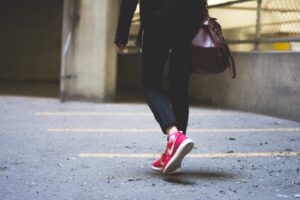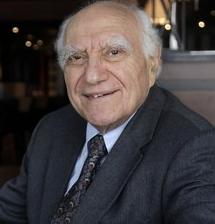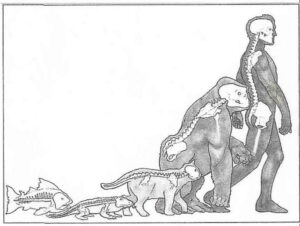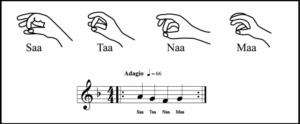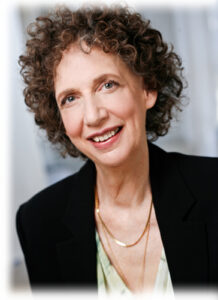Written by Betsy Polatin, MFA, SEP
Reviewed by Nancy Eichhorn PhD
Walking into the grocery store this afternoon, I felt off balance. My left leg felt shorter than my right. I rocked from side to side as if I needed an insert in my left shoe to make my leg as long as the right. I thought: Maybe I need to see a chiropractor to have some sort of adjustment? Maybe it’s time for a massage to release the tension in my lower back? Maybe my left knee hurts (it is swollen and hurts to put weight down when I step) because my right leg is longer and stronger and taking over my forward movement, leaving the left behind? Maybe I need to sit with my knee and see what it needs?
Not my typical internalized conversation about or with my body. Usually, I either dismiss all pain, simply dissociate, and push ahead. I have hiked off trails with a: shattered fibula (just the head), broken finger, puncture wound in my hip and severe gash in my right thigh, and more. I learned how to disconnect from my body early on to survive traumatic situations in my childhood and teenage years.
But now, thanks to Betsy Polatin, I am becoming more aware, conscious, paying attention. I have had many incredible teachers over the years, and Betsy’s new book Humanual: A manual for being human: An Epic Journey to your expanded self, offered me a compelling collection of concepts and user-friendly exercises that helped me pull all my pieces into one cohesive whole. I’m moving, breathing, being with conscious intention and spiritual fluidity and connection far more than before reading this guidebook.
When I opened the book and noted words of praise from numerous colleagues I know and trust (Gabor Mate´, Stephen W. Porges, Richard Schwartz, Bessel van der Kolk, Ian Macnaughton, and more), I knew I was in for an enlightening experience.
Peter Levine’s opening was supportive. Not surprising as he and Betsy, (SEP certified), co-teach two courses: “Trauma and the Performing Artist” and ‘Trauma in the Public Eye”. They are close colleagues and friends. She shares his “Voo” breath exercise to help regulate/tone the vagus nerve (pg. 57) as well as other Somatic Experiencing exercises in the book.
Reading about her early experiences with Albert Pesso—co-founder of Pesso Boyden System Psychomotor (1929-2016), brought tears and heartfelt memories of my time with Al. Betsy shares her remembrance of consciously understanding for the first time how much is said with body communication and how powerful movement language can be—she initially trained with him in 1968, at the start of his explorations into dance, choreography, and movement.
“It was amazing to me how emotions and feelings could be so influenced by the meeting of eyes and the opening of arms,” she shared.
Reading her background experiences and training, I realized how diverse and expansive her knowledge base and foundational skills are. I’m talking: meditation with Maharishi Mahesh (Harvard Divinity School); yoga with Swami Satchidanada; breath work with Carl Stough; somatic experiencing with Peter Levine; trainings and work with Bessel van der Kolk and Stephen W. Porges; training in the Alexander Technique, and so many more.
She has spent the past 50 years of her life “training, clearing and exploring”—and draws on her decades of work with actors, singers, musicians, athletes, and people seeking assistance to help achieve their peak performance and/or realize their unique potential.
The power in this book is fueled by its comprehensive, detailed, user-friendly focus on embodied expansion. The content, as presented (text, pictures, guided exercises, reflection) is designed to help readers find that something inside themselves to connect, deeply and consciously, with their mind, body, soul and spirit (henceforth noted as our ‘being’ in this review).
According to Betsy, she offers a new way to integrate what we do in terms of the body, movement, and trauma:
“The unity and the ‘How’ you move can release past overwhelm and trauma. Many people say move or breath, but they do not fill in the piece of the ‘how’ or address conscious ‘use’, and relate it to the unity of body, mind, spirit. After a session, they do not say bring your conscious awareness to your feet as you walk. And the people who say bring your conscious awareness to your feet as you walk, do not talk at all about trauma. So, I think adding the spiritual and the unity to that combination seems new” (personal communication, October 29, 2020).
Betsy shares how the body is organized to move (developmentally, evolutionarily), how our mind forms, and the patterns that result from these experiences and how adaptive patterns that no longer serve us “can be transformed along with their lingering effects”. I appreciated the inclusion of spiritual practices that affect our ‘being’ and overall consciousness. Her book is “a summation of observations and experiences that emphasize unity and oneness.”
My notes and my reflections in my HUM Journal (her name for a place to capture written reflections of the “EX-plorations” and “EX-ercises” in the book) are as expansive as my movements into her offerings. I have told numerous clients to buy her book for both the content and the layout. The writing style is reflective of a wise knower—there is depth without overwhelm, there is clarity in summary. I noted concepts I read about in graduate school including those by Susan Aposhyan, Christine Caldwell, Ron Kurtz, Dan Siegel, Daniel Stern, D. W. Winnicott, John Bolby, William James, Carl Gustav Jung, and more. As well as others in our field that I learned from or about including: Emilie Conrad, the founder of Continuum Movement; Darrell Sanchez and his work with balance, gravity, and movement; Meister Eckhart (a noted German philosopher and mystic) and Thomas Huebl, a contemporary spiritual teacher.
There are easy to do exercises that you can do without a video guide, an audio recording, someone leading you. You can find the space and spiral, you can raise and lower your arms and note the movement or not in your shoulders, your rib cage. You can sit in a chair and feel your feet, connect with your sitz bones. The concepts are simple, yet the resulting experience invites deeper curiosity.
The basics:
- Support: embodied tracking of our inner supportive sensations, combined with the universal forces of gravity and antigravity
- Suspension: the concept that all our muscles are slightly lengthened for balance and efficient functioning with a moveable balance between expansion and contraction forces and
- Multidimensional breath: our breath reflects every thought, emotion and movement.
There are numerous additional themes as well woven in the three parts of this text that bring readers into and through a journey that if taken with intention and reflection, has the potential to result in significant changes. I appreciated her inclusion of joy, laughter, play and how swaying, rocking, rolling, and bouncing all invite aliveness into our body. A question she offered, stays with me: “Is this contributing to my health and well-being, and a fuller version of myself or not?” (pg. 215). I take a moment to reflect before making a choice. Being in the moment, conscious.
And her comment about meditation:
“The best meditation practice is the one you will do.”
©2015, Alzheimer’s Research & Prevention Foundation, reproduced by permission. www.alzheimersprevention.org
I had an intuitive and conscious sense about my choice of meditation: the Kirtan Kriya. It involves breath, voice, movement, mindfulness, presence. It’s a combination of all that Betsy discusses in her book (though she does not mention this form of meditation). It is a logical choice for me, in light of reading this book, because I do not sit still. The Kirtan Kriya meets my needs to be in a space of quiet practice and mindfulness without distraction. My ‘being’ knew what I needed. I just need to stick with the practice and not give my time away to work, family, the almighty ‘To Do List’ that pulls me away from me.
To come to a sense of completion, I offer that it is tempting to share several of her exercises with you. And to respect Betsy and her publishers, I will, instead:
Offer a link for you to explore inside the book at Amazon
https://www.amazon.com/dp/B089ZYPG1D/ref=dp-kindle-redirect?_encoding=UTF8&btkr=1
learn more about her work on her Facebook page
https://www.facebook.com/theactorssecret/
and her website humanual.com
and invite you to contact Betsy, share your thoughts, etc. I think it is well worth your time: info@humanual.com
About Betsy Polatin
An internationally recognized breathing/movement specialist and best-selling author, Betsy Polatin, MFA, SEP, has been teaching for more than forty years and is currently a master lecturer at Boston University’s College of Fine Arts. Her background includes forty-five years of movement education and performance, as well as training in the Alexander Technique, music, dance, yoga, meditation, trauma resolution, and the broader healing arts. Her work is greatly influenced by the teachings of Spiritual and Meditation Masters.
Betsy leads international trainings where she presents her unique and revolutionary fusion of ideas: scientific knowledge combined with ancient wisdom and intuitive human creativity. Since 2016, she has been co-teaching ongoing workshops with Peter A. Levine, PhD. And she has taught “Returning to Ourselves, the Wisdom of Trauma,” with Dr. Gabor Maté.
Betsy’s previous book, The Actor’s Secret, was featured on ABC TV and Fox News, and received rave reviews. As a well-known educator, she has published numerous articles in the Huffington Post. She maintains a private practice online internationally. Please visit: HUMANUAL.com
Photo Credits
DNA Image by Gerd Altmann from Pixabay
Walking Photo by bantersnaps on Unsplash
Evolution image from Humanual



